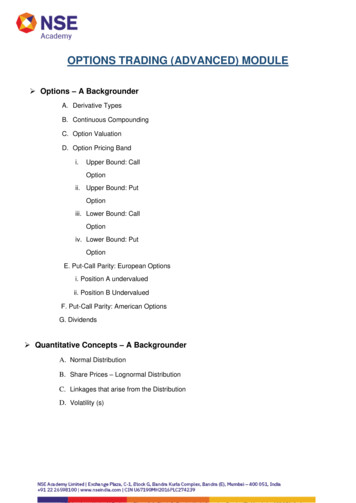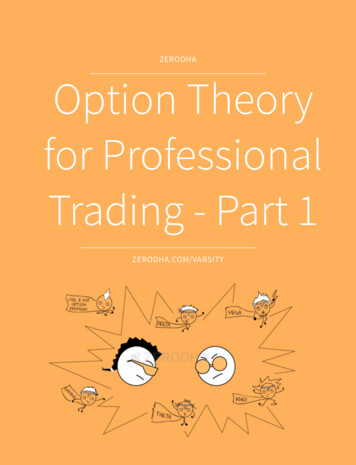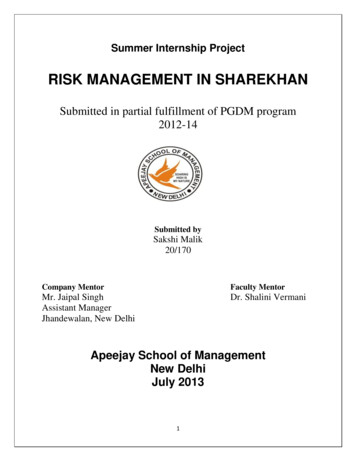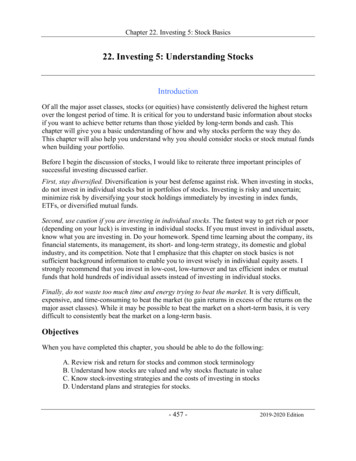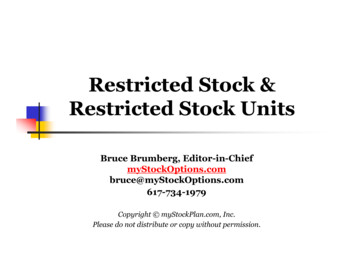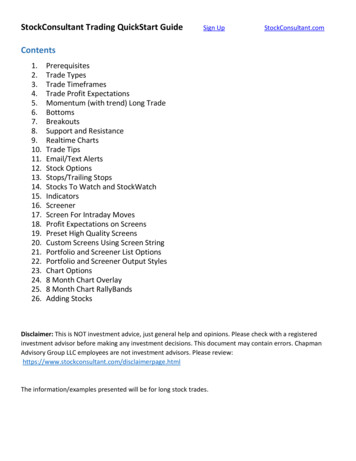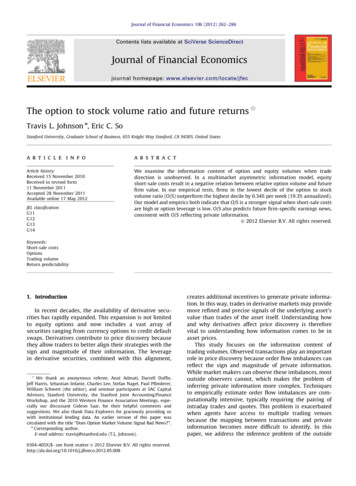
Transcription
Journal of Financial Economics 106 (2012) 262–286Contents lists available at SciVerse ScienceDirectJournal of Financial Economicsjournal homepage: www.elsevier.com/locate/jfecThe option to stock volume ratio and future returns Travis L. Johnson n, Eric C. SoStanford University, Graduate School of Business, 655 Knight Way Stanford, CA 94305, United Statesa r t i c l e in f oabstractArticle history:Received 15 November 2010Received in revised form11 November 2011Accepted 28 November 2011Available online 17 May 2012We examine the information content of option and equity volumes when tradedirection is unobserved. In a multimarket asymmetric information model, equityshort-sale costs result in a negative relation between relative option volume and futurefirm value. In our empirical tests, firms in the lowest decile of the option to stockvolume ratio (O/S) outperform the highest decile by 0.34% per week (19.3% annualized).Our model and empirics both indicate that O/S is a stronger signal when short-sale costsare high or option leverage is low. O/S also predicts future firm-specific earnings news,consistent with O/S reflecting private information.& 2012 Elsevier B.V. All rights reserved.JEL classification:G11G12G13G14Keywords:Short-sale costsOptionsTrading volumeReturn predictability1. IntroductionIn recent decades, the availability of derivative securities has rapidly expanded. This expansion is not limitedto equity options and now includes a vast array ofsecurities ranging from currency options to credit defaultswaps. Derivatives contribute to price discovery becausethey allow traders to better align their strategies with thesign and magnitude of their information. The leveragein derivative securities, combined with this alignment, We thank an anonymous referee, Anat Admati, Darrell Duffie,Jeff Harris, Sebastian Infante, Charles Lee, Stefan Nagel, Paul Pfleiderer,William Schwert (the editor), and seminar participants at SAC CapitalAdvisors, Stanford University, the Stanford Joint Accounting/FinanceWorkshop, and the 2010 Western Finance Association Meetings, especially our discussant Gideon Saar, for their helpful comments andsuggestions. We also thank Data Explorers for graciously providing uswith institutional lending data. An earlier version of this paper wascirculated with the title ‘‘Does Option Market Volume Signal Bad News?’’.nCorresponding author.E-mail address: travisj@stanford.edu (T.L. Johnson).0304-405X/ - see front matter & 2012 Elsevier B.V. All rights .05.008creates additional incentives to generate private information. In this way, trades in derivative markets may providemore refined and precise signals of the underlying asset’svalue than trades of the asset itself. Understanding howand why derivatives affect price discovery is thereforevital to understanding how information comes to be inasset prices.This study focuses on the information content oftrading volumes. Observed transactions play an importantrole in price discovery because order flow imbalances canreflect the sign and magnitude of private information.While market makers can observe these imbalances, mostoutside observers cannot, which makes the problem ofinferring private information more complex. Techniquesto empirically estimate order flow imbalances are computationally intensive, typically requiring the pairing ofintraday trades and quotes. This problem is exacerbatedwhen agents have access to multiple trading venuesbecause the mapping between transactions and privateinformation becomes more difficult to identify. In thispaper, we address the inference problem of the outside
T.L. Johnson, E.C. So / Journal of Financial Economics 106 (2012) 262–286observer by examining the information content of optionand equity volumes when agents are privately informedbut trade direction is unobserved.We provide theoretical and empirical evidence thatinformed traders’ private information is reflected in O/S,the ratio of total option market volume (aggregated acrosscalls and puts) to total equity market volume. The O/Smeasure was first coined and studied by Roll, Schwartz,and Subrahmanyam (2010), whose findings suggest thatcross-sectional and time-series variation in O/S could bedriven by informed trade. As a natural extension of thesefindings, we examine the relation between O/S and futurereturns. Empirically, we find that contrasting publiclyavailable totals of firm-specific option and equity volumeportends directional prices changes, in particular that lowO/S firms outperform the market while high O/S firmsunderperform. At the end of each week, we sort firms byO/S and compute the average return of a portfolio consisting of a short position in stocks with high O/S and a longposition in stocks with low O/S. This portfolio provides anaverage risk-adjusted hedge return of 0.34% in the weekfollowing the formation date (19.3% annualized).If option volume is concentrated among risky firmswith higher return volatility, one might anticipate theopposite result, namely that firms with higher O/S earnhigher future returns. While our finding is inconsistentwith this risk-based explanation, we take several steps tomitigate concerns that exposure to other forms of risk(liquidity risk, for example) explains the O/S-returnrelation. First, we show that the relation holds aftercontrolling for exposure to the three Fama-French andmomentum factors. Second, we show that the predictivepower of O/S for future returns is relatively short-lived.Strategy returns rapidly decline from 0.34% in the firstweek following portfolio formation and become statistically insignificant beyond the sixth week. Third, to mitigate concerns that our results are driven by static firmcharacteristics correlated with O/S and expected returns,we show that two measures of within-firm changes in O/Salso predict future returns.We argue that the negative relation between O/S andfuture returns is driven by short-sale costs in equitymarkets, which make option markets an attractive venuefor traders with negative news. Motivated by this story,we model the capital allocation decision of privatelyinformed traders who can trade in option and equitymarkets. Equity short-sale costs lead informed agentsto trade options more frequently for negative signalsthan positive ones, thus predicting a negative relationbetween relative option volume and future equityvalue. An important innovation of our paper is that thisrelation does not require classifying trades as beingbuyer- versus seller-initiated. Instead, our theoreticalpredictions and empirical tests rely on publicly availablevolume totals.Having established the negative cross-sectional relation between O/S and future returns, we next test ourmodel’s prediction that this relation is stronger whenshort-sale costs are high. As short-sale costs increase,informed traders are more likely to switch from equitiesto options for negative signals, which strengthens the263O/S-return relation. We test this prediction using threedifferent measures of short-sale costs. The first measure isderived from institutional ownership, as in Nagel (2005),and is available throughout our 1996–2010 sample window. We also use two direct measures of short-sale costs,transacted loan fees and available loan supply, from aproprietary database of institutional lending that is available on a monthly basis from 2002 through 2009. Acrossall three measures, we find that portfolio alphas associated with O/S are generally increasing in the cost ofshorting, though the statistical significance of this patternis mixed.An additional empirical prediction arising from ourmodel is that the O/S-return relation is weaker whenoption leverage is high. As option leverage increases, bid–ask spreads in options markets increase, which weakensthe O/S-return relation because the bid–ask spread actslike a switching cost for traders considering the use ofoptions to avoid short-sale costs. When option marketbid–ask spreads are larger, fewer traders switch fromequities to options for negative signals, and the O/Sreturn relation is therefore weaker. Empirically, we findthat portfolio alphas associated with O/S are monotonically decreasing in option leverage.It may be initially puzzling why we do not find arelation between the ratio of call to put volume and futurereturns. Our model demonstrates that O/S provides aclearer signal of private information than the ratio of callto put volume because call volume could be good news(if informed traders are buying) or bad news (if informedtraders are selling), and put volume is similarly ambiguous. Thus, in the absence of information about the signof each trade (i.e., buy vs. sell), O/S is an indication of thesign of private information while the ratio of call to putvolume is not. Our model does, however, predict apositive relation between call–put volume differencesand future return skewness because informed tradersbuy calls (puts) for extremely good (bad) news and sellcalls (puts) for moderately bad (good) news. Consistentwith this prediction, we show empirically that the ratio ofcall volume to put volume predicts return skewness in thesubsequent week.We also find that O/S predicts the sign and magnitudeof earnings surprises, standardized unexplained earnings,and abnormal returns at quarterly earnings announcements in the following week. These tests show that thesame O/S measure we use to predict weekly returns alsocontains information about future earnings announcements that occur in the subsequent week. This is consistent with O/S reflecting private information that isincorporated into equity prices following a subsequentpublic disclosure of the news.The rest of the paper is organized as follows. We beginin Section 2 by discussing our results in the context ofexisting literature. We model the multimarket price discovery process and formalize the equilibrium strategy ofinformed traders in Section 3. In Section 4, we describethe data, methodology, empirical results, and robustnesschecks. Finally, we present results pertaining to quarterlyearnings announcements in Section 5 and conclude inSection 6.
264T.L. Johnson, E.C. So / Journal of Financial Economics 106 (2012) 262–2862. Relation to literatureThe two immediate antecedents of our work areEasley, O’Hara, and Srinivas (1998), hereafter referred toas EOS, and Roll, Schwartz, and Subrahmanyam (2010),hereafter RSS. EOS contains a multimarket equilibriummodel wherein privately informed traders are allowed totrade in both option and equity markets.1 The EOS modelhighlights conditions under which informed traderstransact in both option and equity markets, and predictsthat directional option volume signals private informationnot yet reflected in equity prices. Specifically, their modelpredicts that positive trades (i.e., buying calls and sellingputs) are positive signals of equity value and that negativetrades (i.e., selling calls and buying puts) are negativesignals of equity value. An interesting but otherwiseunexplored empirical finding in EOS is that negativeoption market activity carries greater predictive powerfor future price changes. EOS comment on this finding inthe following excerpt:An interesting feature of our results is the asymmetrybetween the negative- and positive-position effects ysuggesting that options markets may be relativelymore attractive venues for traders acting on ‘‘bad’’news. An often-conjectured role for options markets isto provide a means of avoiding short-sales constraintsin equity markets y Our results support this conjecture, suggesting a greater complexity to the mechanism through which negative information is impoundedinto stock prices [p. 458].We provide a formal means of understanding theirfinding by introducing short-sale costs into a microstructure framework with asymmetric information. Like EOS,informed agents trade with a risk-neutral market maker,and can buy or sell shares of stock, buy or sell calls, or buyor sell puts. Unlike EOS, we impose short-sale costs thatplay a central role in determining which assets informedtraders choose to trade. It is comparatively cheaper tocapitalize on bearish private signals in option marketsbecause traders can buy puts or sell calls, and in bothcases they can create new option contracts without firstborrowing them from a third party. In our model’sequilibrium, the costs associated with short-selling makeinformed traders more likely to use options for badsignals than for good ones and, as a result, high O/Sindicates negative private information and low O/S indicates positive private information.Like EOS, we solve a static model and therefore needthe additional assumption that some friction preventsequity prices from immediately reflecting the informationin option volumes in order for the model’s predictionabout the conditional mean equity value to translate intoreturn predictability. Our main empirical prediction, thatO/S is a negative cross-sectional signal of future returns,1The authors point out that asymmetric information violates theassumptions underlying complete markets and, therefore, the optiontrading process is not redundant. Consistent with this idea, Bakshi, Cao,and Chen (2000) find that Standard & Poors (S&P) 500 call optionsfrequently move in the opposite direction of equity prices.differs from EOS in that it can be tested empiricallywithout signing the direction of trades. We predict andconfirm that contrasting publicly available totals of firmspecific option and equity volume portends directionalprice changes.Empirically, our study of the relation between O/S andfuture returns is a natural extension of the work in RSS,which introduces the option to stock volume ratio, andcoins it O/S. The authors find substantial intertemporaland cross-sectional variation in O/S, and explain a significant part of this variation in a regression framework.In particular, O/S is increasing in firm size and impliedvolatility but decreasing in option bid–ask spreads andinstitutional holdings. Our results shed additional light onthe variation in O/S by examining the theoretical determinants of relative option volume when a subset ofmarket participants is privately informed, and the empirical relation between O/S and future returns. RSS alsoshow that O/S in the days immediately prior to announcement predicts the magnitude of returns at earningsannouncements, consistent with O/S reflecting traders’private information. Conditional on there being positive(negative) earnings news, they find that O/S predictshigher (lower) announcement returns (see Section 5 formore details). Our analysis builds upon this finding bydemonstrating an unconditional predictive relationbetween the prior week’s O/S and earnings surprises.Another recent paper examining option volume is Roll,Schwartz, and Subrahmanyam (2009), which shows apositive cross-sectional relation between Tobin’s q andunscaled option volume. The authors interpret this asevidence that liquid option markets increase firm valuebecause they help complete markets and generateinformed trade. Our model and empirical tests supportthis intuition by demonstrating that option markets arean attractive venue for informed traders.The results of this paper also relate to the literature onprice discovery and information flow in multiple markets.2 Pan and Poteshman (2006) use proprietary ChicagoBoard Options Exchange (CBOE) option market data andprovide strong evidence of informed trading in optionmarkets. The authors find that sorting stocks by theamount of newly initiated positions in puts relative tocalls foreshadows future returns but they conclude thepredictability is not due to market inefficiencies andinstead reflects the fact that their volume measure isnot publicly observable. A key innovation of our paper isdemonstrating that publicly available, non-directionalvolume totals predict future returns. Similarly, Cremersand Weinbaum (2010) and Zhang, Zhao, and Xing (2010)find that publicly available asymmetries in impliedvolatility across calls and puts predict future returns.Prior research establishes that equity volume, thedenominator of our primary return predictor O/S, is useful2Whether option markets lead equity markets or vice versa remainsan open question. Anthony (1988) examines the interrelation of stockand option volumes and finds that call-option activity predicts volumein the underlying equity with a one-day lag. Similar findings arereported in Manaster and Rendleman (1982). In contrast, Stephan andWhaley (1990) find no evidence that options lead equities.
T.L. Johnson, E.C. So / Journal of Financial Economics 106 (2012) 262–286by itself in predicting future returns, though the directiondepends on the way volume is measured (see, e.g., Gervais,Kaniel, and Mingelgren, 2001; Lee and Swaminathan, 2000;Brennan, Chordia, and Subrahmanyam, 1998). We decoupleO/S into separate measures of equity and option volume andshow that past option volume is negatively related to futurereturns incremental to past equity volume. Other extantwork uses equity volume as a conditioning variable forexamining the relation between past and future returns.Specifically, Lee and Swaminathan (2000) show that high(low) volume winners (losers) experience faster momentumreversals, and Llorente, Michaely, Saar, and Wang (2002)show that the relation between equity volume and returnautocorrelation changes sign depending on the amount ofinformed trading for a given equity.During the 2008 financial crisis, the U.S. Securities andExchange Commission (SEC) banned short sales for 797‘‘financial’’ stocks, providing an interesting case study ofthe impact of short-sale costs on options markets. BothBattalio and Schultz (2011) and Grundy, Lim, andVerwijmeren (in press) find that option market spreadsincreased and option market volume decreased for firmssubject to the ban relative to those exempt from it. A keycomponent of our model is that option markets serve asan alternative venue for negative news when shorting iscostly, and at first glance, the 2008 episode contradictsthis premise. However, as emphasized in Battalio andSchultz (2011), the short-sale ban also imposed costs onoption market makers who short equity, making it moredifficult for them to hedge when selling puts or buyingcalls. In our model, increasing costs for market makerswho write puts or buy calls will increase spreads anddecrease volume in option markets, while banning shortswill increase both spreads and volume in options markets.Our model therefore suggests we interpret the decrease inoption market volume during the 2008 ban as a result ofthe added costs of shorting for market makers outweighing the relocation of trades stemming from negativeinformation to option markets.In modelling the relation between short-sale costs andinformed trading, our paper is also related to Diamondand Verrecchia (1987), which models the impact of shortsale constraints on the speed of adjustment of securityprices to private information when informed traders onlyhave access to equity markets. In their model, short-saleconstraints cause some informed parties with negativeinformation not to trade. Thus, the absence of trade intheir model is a negative signal of future firm value. In ourmodel, trading options is an alternative to abstaining fromtrade when the cost of shorting is high. As a result, a highoption volume ratio, rather than the absence of trade,reflects negative private information.265costly to trade on bad news in the stock market, inequilibrium the mean equity value conditional on anoption trade is lower than the mean equity value conditional on a stock trade.There are three tradable assets in the model: an equity,a call option, and a put option. The stock liquidates for V at time t¼2 in the future. The value of V is unknown priorto t ¼2, but it is common knowledge thatV ¼ m þ E þ Z ,ð1Þwhere m is the exogenous mean equity value, and E and Z are independent, normally distributed shocks with zeromean and variances s2E and s2Z . The call and put are bothstruck at m, and both expire at time t ¼2. We focus on thecase of European options with a single strike pricebecause our aim is to model the choice between tradingoptions and trading equities, as opposed to the choiceamongst options of different strikes or times to expiration. We use m as a strike price so that calls and puts havethe same leverage.Trade occurs at time t ¼1, at which point a fraction a ofthe traders (henceforth ‘‘informed traders’’) know therealization of E but the remaining traders, and the marketmaker, do not. The distribution of V conditional on theinformation that E ¼ E isV 9ðE ¼ EÞ Nðm þ E, s2Z Þ:ð2ÞInformed traders are risk-neutral, and therefore value thestock, call, and put usingEðV 9E ¼ EÞ ¼ m þ E,EðC 9E ¼ EÞ ¼ F ð3Þ EEEþfs ,sZsZ Z E ¼ EÞ ¼ F E E þ f E sZ ,EðP9sZsZð4Þð5Þrespectively, where F is the standard normal’s cumulativedistribution function, f is its probability distributionfunction, and C and P are the values of the call and putat t ¼2.We require that each trade be in exactly one type ofasset, resulting in six possible trades: buy or sell stock,buy or sell calls, and buy or sell puts. At equilibriumprices, the informed traders have a strict preferenceamong the assets for all signals other than six cutoffpoints.3 A fraction 1 a of the traders are uninformed andtrade for reasons outside the model, possibly a desire forliquidity, the need to hedge other investments or humancapital, or a false belief that they have information.Regardless of their motivation, uninformed traders chooseamong the same possible transactions as the informedtraders, with fractions q1, q2, q3, q4, q5, and q6 choosing to3. The modelWe present a model of informed trading in both equityand options markets in the presence of short-sale costs.Informed traders build a portfolio by trading sequentiallywith a competitive, risk-neutral market maker. A keyfeature of our model is that traders must pay a lendingfee to a third party when shorting stock. Because it is3Allowing trades in bundles of multiple assets (for example, one calland two shares) complicates the analysis without changing our resultsor providing additional insight. Bundles serve as ‘‘intermediate’’ portfolios used by the informed trader upon receiving a signal near theirindifference point between the two bundled assets. As long as bundletrades that include a short position in equities require traders to payshort-sale costs, our model still predicts that equity (option) volumereflects positive (negative) private information.
266T.L. Johnson, E.C. So / Journal of Financial Economics 106 (2012) 262–286buy stock, sell stock, buy calls, sell calls, buy puts, and sellPputs, respectively, where 6i ¼ 1 qi ¼ 1.A competitive and risk-neutral market maker posts bidand ask prices for all three assets that result in zeroexpected profit for each trade.4 For notation, we writeas, bs, ac, bc, ap, and bp for the ask and bid prices of thestock, call, and put, respectively. As in EOS and Glostenand Milgrom (1985), trades occur sequentially and atfixed order sizes: g shares of stock and y options contracts. Unlike EOS, we assume throughout that y 42g sothat options trades allow more exposure to the underlying than stock trades, an intuition expressed in Black(1975) as well as EOS and RSS (see Appendix B for details).A critical new ingredient in our model is a short-salecost paid by the trader to a third party who lends themthe shares. The fee is a fraction r 40 of the total amountshorted gbs . The lender is able to charge such a feebecause they have some market power, or because thereis some counterparty risk. No such fee exists whenwriting options because there is no need to find a contractto borrow—the market maker can create a new contract.The parameter r can also represent a reduced form of anycost to shorting stock; for example, recall risk or theindirect costs described in Nagel (2005). Regardless of r’sinterpretation, the market maker pays gbs for g shares, butthe trader only nets gbs ð1 rÞ from the transaction.53.1. EquilibriumAn equilibrium in our model consists of an optimaltrading strategy for informed traders as a function of theirsignal, and bid–ask prices and quantities that yield zeroexpected profit for the market maker. In equilibrium,informed traders use the following cutoff strategy f ðEÞthat maps the range of possible signals to the space ofpossible trades:8buy putsfor E rk1 , sell stockfor E 2 ðk1 ,k2 , for E 2 ðk2 ,k3 , sell callsð6Þf ðEÞ ¼ make no trade for E 2 ðk3 ,k4 , E2ðk,k ,sellputsfor 54 for E 2 ðk5 ,k6 , buy stock :buy callsfor E 4k6 :For extremely good or bad signals, informed tradersbuy options despite large bid–ask spreads in these markets because they provide greater leverage. The bid–askspreads make options unattractive for weaker signals, andso informed traders trade equities instead. For evenweaker good or bad signals, however, informed traders4In the model, additional market makers have no impact as long asthey are risk-neutral and competitive. The return predictability evidencein this paper suggests there is some segmentation between option andequity markets, perhaps because they have different market makers.5It is important for our argument that option market makers do notpay the short-sale cost r in the course of hedging their position, andtherefore embed the short-sale cost in option prices. In reality, optionmarket makers have access to cheaper shorting than ordinary investors,and therefore the option-embedded short-sale cost is smaller than theactual short-sale cost in equity markets.value the stock near its unconditional mean and thereforecannot profitably trade stock. However, they value theoptions well below their unconditional mean becauseextreme outcomes occur with lower probabilities, andtherefore sell options. If bid prices are below informedtraders’ valuation of both a put and a call for a givensignal, informed traders choose not to trade. The cutoffpoints ki arise endogenously in equilibrium and arechosen so that informed traders strictly prefer writingputs for all E o k1 , selling stock for all k1 o E o k2 , etc.Some regions can be empty in equilibrium, meaningki ¼ ki þ 1 for some i. The addition of short-sale costsshrinks the region of signals for which informed tradersshort stock ðk1 ,k2 .The bid and ask prices for each asset (as, bs, ac, bc, ap,and bp) and the informed traders’ cutoff points ki are the12 equilibrium parameters. Together they satisfy 12equations, presented fully in Appendix A, which assurethat the market maker’s expected profit is zero for eachtrade and that informed traders are indifferent betweenthe two relevant trades at each cutoff point.3.2. Results and empirical predictionsDue to the nonlinearity of the simultaneous equations,no closed-form solution for the equilibrium parameters isavailable. We derive our results and empirical predictionsfrom the simultaneous equations. Our focus is on theinformation content of trading volumes when there areshort-sale costs, so we assume throughout that r 4 0.Proofs are in Appendix C.Result 1. When each asset is equally likely to be bought orsold by an uninformed trader, the stock is worth lessconditional on an option trade than it is conditional on astock trade.Empirical Prediction 1. Option volume, scaled by volume inthe underlying equity, is negatively related to future stockreturns.The main result is that an option trade is bad news forthe value of the stock and a stock trade is good news,which differs from EOS in that the conditioning variable isthe location of trade rather than the direction of trade.Option volume reflects bad news because informed traders use stocks more frequently to trade on good newsthan bad due to the short-sale cost. Therefore, theexpected equity value conditional on an option trade islower than the unconditional mean, which is in turnlower than the expectation conditional on a stock trade.Result 1 requires that uninformed traders buy and selleach asset with equal probability, but holds regardless ofhow uninformed traders distribute their demand acrossthe different assets; for example, uninformed traders maytrade equities more frequently than options.To translate Result 1 into an empirical prediction, weconsider the implications of our static model in a multiperiod setting. If equity markets fully incorporate theinformation revealed through options trading into theirvaluations, stock prices will immediately reflect the newconditional expectation of V after each option trade.
T.L. Johnson, E.C. So / Journal of Financial Economics 106 (2012) 262–286267Otherwise, stock prices do not fully reflect the information content of options trades for the time between whenthe informed option market trading occurs and when theinformation becomes public through another channel.In this case, there will be a negative relation betweenoption volume and subsequent returns until the publicrelease of the information. Empirical Prediction 1 is,therefore, a joint hypothesis that (a) short-sale costs makeO/S a negative cross-sectional predictor of future prices,and (b) some of the information in O/S reaches equitiesthrough other channels, such as earnings announcements,that occur after the observation of O/S.6Our model makes no prediction about the overallvolume in options and stocks together, only that optiontrades are bad news relative to stock trades. Our goal is tofocus on informed traders’ choice between equities andoptions, conditional on having a signal about the futurevalue of a firm. Therefore, our predictive measure is theratio of option volume to equity volume, rather thanunscaled option volume.Empirically, Result 3 suggests that volume in optionsmarkets with higher leverage provides a weaker signalthan volume in options markets with lower leverage. Fora measure of leverage, we use l ¼ ð@C @SÞS C, the elasticity of C with respect to S, reflecting the ‘‘bang-for-th
trade in both option and equity markets.1 The EOS model highlights conditions under which informed traders transact in both option and equity markets, and predicts that directional option volume signals private information not yet reflected in equity prices. Specifically, their model predicts that positive trades (i.e., buying calls and selling
